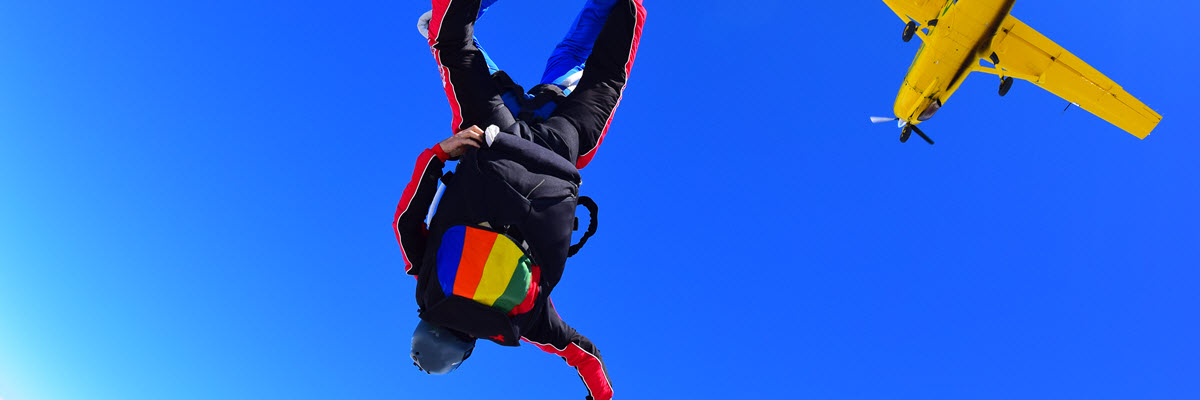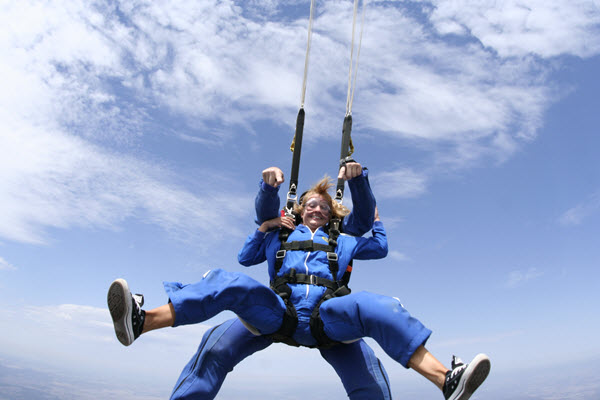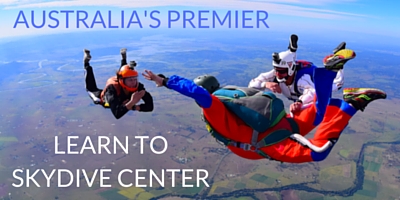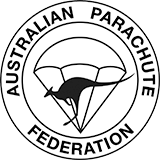- Click to Call +61 7 5423 1159
- Tuesday: 8:00 am - 5:00 pm

How Fast Do You Fall When Skydiving Tandem?
Wednesday, February 27, 2019
- Skydive Ramblers
- 2/27/19
- 0
- General
The short answer: jolly fast.
The longer answer is a glorious trip back through the physics lab and maths class. Prepare for your first time skydiving by unpacking one of the most exhilarating word problems ever. (And you thought you’d “never need to know this stuff” once you left school.)
Calculating Freefall Time
As the term suggests, freefall is the portion of your skydive that takes place between exiting the plane and opening your parachute.
Once you and your tandem instructor leap into the big blue, gravity takes you on the ride of your life as you fall belly to earth at an average of 61 meters (200 feet) every second.
The amount of time you spend in freefall depends on how long it takes you to reach terminal velocity and the altitude from which you jump.
Terminal Velocity
Terminal velocity is the fastest you’ll fall during your jump; typically around 200 kph (120 mph). Your first few seconds in freefall will be a wee bit slower, so you’ll cover a little less distance at first, but then you’ll accelerate to full speed.
The first 300 or so meters (1,000 feet) will take about 10 seconds to fly through. Then 5 seconds for each 300 meters after that. Translation: WooooHOOOOOOO!

Altitude is Everything
At Ramblers, we jump from 14,000 feet up – a wee higher than the average tandem skydive – which means that you’ll be in freefall for about 60 seconds. Awesome.
We also offer tandem skydiving at night – a rare treat, especially for those who are dipping their first toes in the sport. Available when conditions are just right, night jumps exit at 12,000 feet. There’s no better cherry on top to a spectacular day of adventure.
Freefall is Good for You
Freefall is a chemically-rich recipe for your brain that nourishes your mental health, emotional and spiritual well being.
Adrenaline pumps you up, putting you in direct touch with your strength, power and capability.
Serotonin inspires positivity, reinforcing your significance and helping you to regain perspective.
Dopamine is empowering, flooding you with a enriching sense of motivation, exhilaration and excitement.
When you’re in freefall, you can only focus on your bliss. You are, literally, in Peter Pan mode, thinking “of all the joy you find when you leave the world behind and bid your cares goodbye” as you fly, Fly, FLY!!
Playground in the Sky
Falling freely doesn’t mean only falling exclusively belly-to-the-ground. A minute of freefall offers a fair bit of time to experiment with the principles of aerodynamics.
Tilt one arm up and the other down and you can turn around. Straighten your legs and propel yourself forward. First-time skydivers can experience this level of play – just let your instructor know if you’re up for trying it.
Experienced skydivers get up to all sorts of exciting antics whilst sky high. Flying vertically, in a seated position or even upside down is common once you have your confidence.
Competitive skydiving features numerous events, including several that take place during freefall.
Experience Freefall from the Ground
At Ramblers, we offer the amazing opportunity of artificial freefall through our Wind Tunnel Option.
With wind forces of up to 180 kph (112 mph), your ground-level experience is pretty darn close to the real deal – and doesn’t rely on blue skies.
Whether you’re gearing up for your first time skydiving or you’re on your way to your A license, we’re ready for you. Come and jump with us.


Thanks guys was an absolute amazing experience my daughter and I loved it we both will be back again for a second tandem jump in the future a special thanks to Anna and my camera man awesome job guys you both made me feel very safe I highly recommend ramblers skydiving too anybody wishing to experience a skydive.
“highly recommend” – by Craig Johnson
